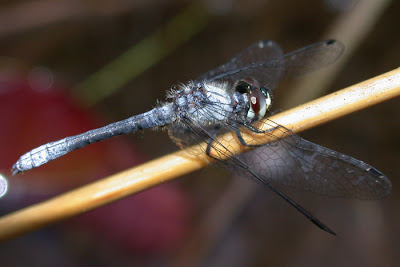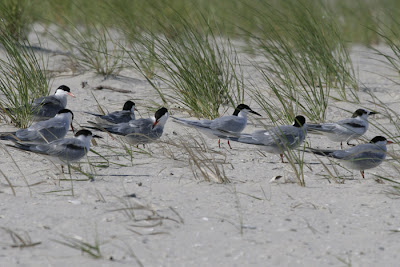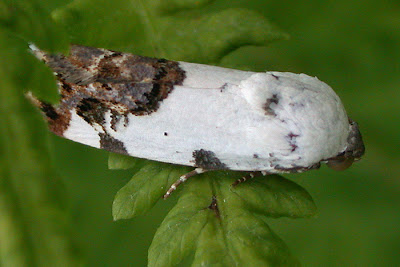As we enter our high summer period, Cape May County really does become a tale of two ends; there are wildlife spectacles to be enjoyed in all corners of the county, but the furthest ends really do offer some wonderful experiences. On my Wednesday walk at Cape May Point State Park this morning, we had the fine sight of at least five
Brown Pelicans fishing among the hordes of
Laughing Gulls and
Forster's Terns out in the rips, a wonderfully starch-white
Roseate Tern was on the beach and the first
Lesser Yellowlegs of Fall blipped all too briefly past. In contrast, our Belleplain Wildlife walks on Sunday mornings take us right up into the northern corner of the county and each week we have consistently enjoyed some fabulous experiences. Birds don't tend to be our main priority on these Belleplain walks (we do them later in the morning after bird activity has tailed off a little), and yet birds nevertheless do feature strongly. Recently, a singing
Yellow-throated Vireo accompanied us for much of our walk and a dayglow
Prothonotary Warbler zipped right across the road in full sunshine. Singing
Black-and-white Warblers and
American Redstarts have featured in these walks too, as well as some stunning dragonflies and awesome orchids - the latter including Rose Pogonia, Grass-pink and the peculiar Green Fringed Orchid.
All of our summer walks continue to provide some great birding opportunities for walk members; at The Beanery,
Black-crowned Night Herons, Blue Grosbeaks and
Orchard Orioles have been a feature, while a pair of
Horned Larks also appears to be breeding there this year, which is great news (keep an eye on our
Field Trips section for all the details on what our walk groups are enjoying!). And don't forget the boat trips on the back bays too - some fine pictures keep winging their way to me from folks enjoying good birding out there!
Elsewhere, Tom Reed consistently reports
Sandwich Tern and occasional
Roseate Tern at Stone Harbor Point, while an interesting
Brown Pelican movement has been taking place offshore, with the largest party involving 21 birds that passed north off Cape May Point on 24th. Up at Brigantine,
Wilson's Phalarope, Snow Goose, Brant and
White-faced Ibis were all still being reported up to a few days ago at least - and more shorebirds will begin to pass through any day now.
Our Belleplain Wildlife walks continue to start with a run through the moths at the state forest headquarters (courtesy of Lorraine McCay and her team - thanks guys!). Recently Tony Leukering had a nice find with a Southern Flannel, a species that the books indicate occurs to the south of New Jersey. Quite good numbers of this species are now appearing at Belleplain and - you have to admit - it is a beast worth seeing! [Photo by Mike Crewe]
Appearing in a wet patch near you right now! Large stands of brilliantly-colored Orange Milkwort make a fabulous sight throughout our region [photo by Mike Crewe].
An orchid highlight for me on a recent Belleplain Wildlife walk was the discovery of a small colony of Green Fringed Orchids - sadly they had been needlessly mown to the ground two days later...[photo by Mike Crewe].
Another tale of two ends - two ends of the size scale: recent visits to Belleplain have turned up a fabulous array of dragonflies, which should be peaking in time for our July 14th dragonfly workshop folks! In one day, I had the delight of seeing Cape May's smallest and its largest dragonfly in the same day. At a mere 0.8 inches long, this male Elfin Skimmer is truly minuscule for a dragonfly - and yet easily as feisty as its larger cousins! [Photo by Mike Crewe]
At the top end of the dragonfly scale, this beast is almost our largest dragonfly (the Swamp Darner just beats it by a nose!). This has the awesome name of Dragonhunter and is a species that specializes in catching and eating other dragonfly species. Note the undersized head (a feature of the clubtail group that it belongs to) and the oversized hind legs [photo by Mike Crewe]
A closer look at the business end of a Dragonhunter [photo by Mike Crewe].
Down at Cape May Point, the ponds at the Rea Farm are producing good views of Black-crowned Night Herons [photo by Karl Lukens].
Common Terns are nesting now in the back bays - this one was photographed on one of our back bay boat trips recently - clearly a great opportunity to get up close and personal with these birds [photo by Beth Polvino].
Breeding-plumaged Common Loons are an all too scarce sight in Cape May County, but this bird has been delighting our boat trip participants regularly of late [photos (above and below) by Beth Polvino].



























































